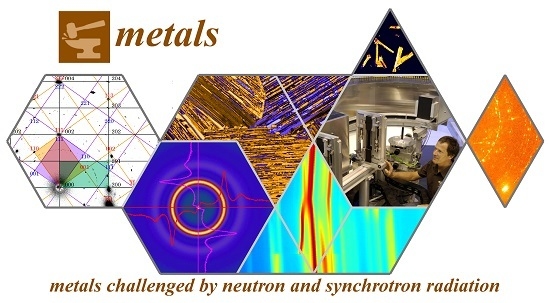Metals Challenged by Neutron and Synchrotron Radiation
1. Introduction and Scope
2. Contributions
2.1. Sintering Techniques and Microstructure Evolution
2.2. Titanium Aluminides and Titanium Alloys under Extreme Conditions
2.3. Metallic Glass and Disordered Crystals
2.4. In Situ and Time-Resolved Response to Mechanic Load and Shock
2.5. Thin Films and Layers
3. Conclusions and Outlook
Conflicts of Interest
References
- Vogel, S.C. A Review of Neutron Scattering Applications to Nuclear Materials. Int. Sch. Res. Not. 2013, 2013, e302408. [Google Scholar] [CrossRef]
- Liss, K.D.; Chen, K. Frontiers of synchrotron research in materials science. MRS Bull. 2016, 41, 435–441. [Google Scholar] [CrossRef]
- Liss, K.D. Quantum Beam Science—Applications to Probe or Influence Matter and Materials. Quantum Beam Sci. 2017, 1, 1. [Google Scholar] [CrossRef]
- Chen, G.; Liss, K.D.; Cao, P. An in situ Study of NiTi Powder Sintering Using Neutron Diffraction. Metals 2015, 5, 530–546. [Google Scholar] [CrossRef]
- Xiao, Y.; Xu, F.; Hu, X.; Li, Y.; Liu, W.; Dong, B. In situ Investigation of Titanium Powder Microwave Sintering by Synchrotron Radiation Computed Tomography. Metals 2016, 6, 9. [Google Scholar] [CrossRef]
- Ma, J.; Li, A.; Tang, H. Study on Sintering Mechanism of Stainless Steel Fiber Felts by X-ray Computed Tomography. Metals 2016, 6, 18. [Google Scholar] [CrossRef]
- Nishijima, H.; Tomota, Y.; Su, Y.; Gong, W.; Suzuki, J. Monitoring of Bainite Transformation Using in Situ Neutron Scattering. Metals 2016, 6, 16. [Google Scholar] [CrossRef]
- Erdely, P.; Schmoelzer, T.; Schwaighofer, E.; Clemens, H.; Staron, P.; Stark, A.; Liss, K.D.; Mayer, S. In Situ Characterization Techniques Based on Synchrotron Radiation and Neutrons Applied for the Development of an Engineering Intermetallic Titanium Aluminide Alloy. Metals 2016, 6, 10. [Google Scholar] [CrossRef]
- Stark, A.; Rackel, M.; Tchouaha Tankoua, A.; Oehring, M.; Schell, N.; Lottermoser, L.; Schreyer, A.; Pyczak, F. In Situ High-Energy X-ray Diffraction during Hot-Forming of a Multiphase TiAl Alloy. Metals 2015, 5, 2252–2265. [Google Scholar] [CrossRef]
- Liss, K.D. Structural Evolution of Metals at High Temperature: Complementary Investigations with Neutron and Synchrotron Quantum Beams. In Magnesium Technology 2017; Solanki, K.N., Orlov, D., Singh, A., Neelameggham, N.R., Eds.; The Minerals, Metals & Materials Series; Springer International Publishing: Cham, Switzerland, 2017; pp. 633–638. [Google Scholar]
- Liss, K.-D.; Funakoshi, K.-I.; Dippenaar, R.J.; Higo, Y.; Shiro, A.; Reid, M.; Suzuki, H.; Shobu, T.; Akita, K. Hydrostatic Compression Behavior and High-Pressure Stabilized β-Phase in γ-Based Titanium Aluminide Intermetallics. Metals 2016, 6, 165. [Google Scholar] [CrossRef]
- Okuchi, T.; Hoshikawa, A.; Ishigaki, T. Forge-Hardened TiZr Null-Matrix Alloy for Neutron Scattering under Extreme Conditions. Metals 2015, 5, 2340–2350. [Google Scholar] [CrossRef]
- Goossens, D.J. Monte Carlo Modelling of Single-Crystal Diffuse Scattering from Intermetallics. Metals 2016, 6, 33. [Google Scholar] [CrossRef]
- Egami, T.; Tong, Y.; Dmowski, W. Deformation in Metallic Glasses Studied by Synchrotron X-Ray Diffraction. Metals 2016, 6, 22. [Google Scholar] [CrossRef]
- Suzuki, H.; Yamada, R.; Tsubaki, S.; Imafuku, M.; Sato, S.; Watanuki, T.; Machida, A.; Saida, J. Investigation of Elastic Deformation Mechanism in As-Cast and Annealed Eutectic and Hypoeutectic Zr–Cu–Al Metallic Glasses by Multiscale Strain Analysis. Metals 2016, 6, 12. [Google Scholar] [CrossRef]
- Guo, G.-Q.; Wu, S.-Y.; Luo, S.; Yang, L. How Can Synchrotron Radiation Techniques Be Applied for Detecting Microstructures in Amorphous Alloys? Metals 2015, 5, 2048–2057. [Google Scholar] [CrossRef]
- Guo, G.-Q.; Wu, S.-Y.; Luo, S.; Yang, L. Detecting Structural Features in Metallic Glass via Synchrotron Radiation Experiments Combined with Simulations. Metals 2015, 5, 2093–2108. [Google Scholar] [CrossRef]
- Kwon, E.P.; Sato, S.; Fujieda, S.; Shinoda, K.; Kainuma, R.; Kajiwara, K.; Sato, M.; Suzuki, S. Characterization of Deformation Behavior of Individual Grains in Polycrystalline Cu-Al-Mn Superelastic Alloy Using White X-ray Microbeam Diffraction. Metals 2015, 5, 1845–1856. [Google Scholar] [CrossRef]
- Ichiyanagi, K.; Nakamura, K.G. Structural Dynamics of Materials under Shock Compression Investigated with Synchrotron Radiation. Metals 2016, 6, 17. [Google Scholar] [CrossRef]
- Lee, S.Y.; Huang, E.-W.; Woo, W.; Yoon, C.; Chae, H.; Yoon, S.-G. Dynamic Strain Evolution around a Crack Tip under Steady- and Overloaded-Fatigue Conditions. Metals 2015, 5, 2109–2118. [Google Scholar] [CrossRef]
- Lee, S.Y.; Wang, H.; Gharghouri, M.A. Twinning-Detwinning Behavior during Cyclic Deformation of Magnesium Alloy. Metals 2015, 5, 881–890. [Google Scholar] [CrossRef]
- Demkowicz, M.J.; Majewski, J. Probing Interfaces in Metals Using Neutron Reflectometry. Metals 2016, 6, 20. [Google Scholar] [CrossRef]
- Callori, S.J.; Rehm, C.; Causer, G.L.; Kostylev, M.; Klose, F. Hydrogen Absorption in Metal Thin Films and Heterostructures Investigated in Situ with Neutron and X-ray Scattering. Metals 2016, 6, 125. [Google Scholar] [CrossRef]
- Kidena, K.; Endo, M.; Takamatsu, H.; Niibe, M.; Tagawa, M.; Yokota, K.; Furuyama, Y.; Komatsu, K.; Saitoh, H.; Kanda, K. Resistance of Hydrogenated Titanium-Doped Diamond-Like Carbon Film to Hyperthermal Atomic Oxygen. Metals 2015, 5, 1957–1970. [Google Scholar] [CrossRef]
© 2017 by the author. Licensee MDPI, Basel, Switzerland. This article is an open access article distributed under the terms and conditions of the Creative Commons Attribution (CC BY) license (http://creativecommons.org/licenses/by/4.0/).
Share and Cite
Liss, K.-D. Metals Challenged by Neutron and Synchrotron Radiation. Metals 2017, 7, 266. https://doi.org/10.3390/met7070266
Liss K-D. Metals Challenged by Neutron and Synchrotron Radiation. Metals. 2017; 7(7):266. https://doi.org/10.3390/met7070266
Chicago/Turabian StyleLiss, Klaus-Dieter. 2017. "Metals Challenged by Neutron and Synchrotron Radiation" Metals 7, no. 7: 266. https://doi.org/10.3390/met7070266





